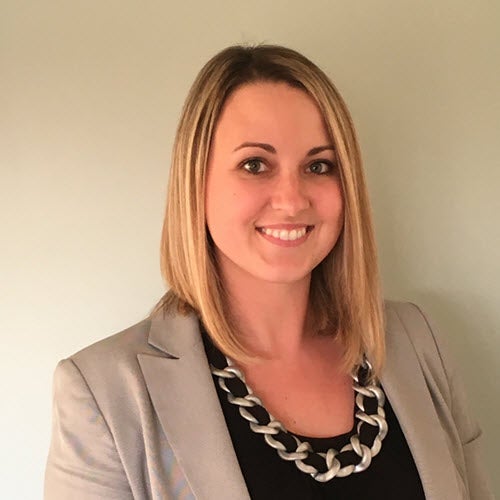Spotlight Feature

Lacey Binnendyk
Operations Director,
Riverside Medical Center
Kankakee, Ill.
Background: When health care leaders at Riverside Medical Center saw Kankakee County’s latest health needs assessment data, the results weren’t good for the community located just south of Chicago. In order to address growing concerns about chronic health conditions affecting residents in its surrounding communities, Riverside focused on helping people improve their overall health by making positive changes to their daily routines. With funding and technical assistance from the health equity grant collaboration between the American Hospital Association’s Institute for Diversity and Health Equity (IFDHE) and Blue Cross Blue Shield of Illinois (BCBSIL), Riverside implemented a new program to provide better access to nutritious food to help residents lower their risk of developing heart disease, diabetes and other serious health conditions. Lacey Binnendyk, operations director at Riverside, talks about how the hospital teamed up with primary care providers and local organizations to make a positive impact.
Why did your health system decide to move forward with this new initiative?
Our most recent Kankakee County Health Needs Assessment (KCHNA) identified heart disease as the number two cause of death in the county. Lack of physical activity, poor nutrition, tobacco use and excessive alcohol consumption were linked to these early deaths and chronic diseases. As a result, two of the KCHNA strategies we developed were to use primary care providers to push preventative care and screenings and create access to affordable, healthy foods. The assessment data identified that 14% of county residents say they have food insecurities. With this information, our initiative was to improve access to healthy foods, education in support of better health outcomes for patients and families.
“Partnering with another organization has provided great insight and a new set of expectations as we support our community.”
What is the goal of your program and how do you anticipate your efforts will impact patients?
Our primary focus was reducing the A1C levels of diabetics with food insecurities by 5% within the first six months of our program, which launched last July. We also anticipated a 2% reduction in inpatient readmission rates by Dec. 31, 2020.
To date, our data reflect great success. We have improved 51% of our diabetic patients’ A1C levels and have not had any hospital readmissions for the patients of our cohort group. We also have increased access to healthy food options – encouraging paticipants to utilize the food pantry while focusing on how we can sustain our progress.
How did community partnerships factor into efforts to build this new program?
Our program is designed to help families with financial and food-access barriers secure nutritious, healthy foods and educational resources, thus improving individual and family health outcomes. To make that happen, we partnered with the Northern Illinois Food Bank to get more nutritious foods to more people in need. Our Riverside Endocrinology, East Court and Pembroke Primary Care clinicians now screen all patients for food insecurities using the U.S. Department of Agriculture’s screening questionnaire, while also screening for co-morbidities related to diabetes and heart failure. Patients who screen positive for food insecurities and have one or both of these co-morbidities receive access to food from the Rx Mobile Pantry. As a result of this partnership, 6,000 pounds of fresh produce, frozen meats and dairy and non-perishable items are delivered locally on a monthly basis.
Through our strong partnership with Northern Illinois Food Bank, patients have received healthy food resources and we have provided noteworthy wrap-around services, despite challenges brought on by COVID-19. This support consists of phone calls from our population health team, diabetic educator and/or cardiology nurse, as well as nutritional education guides, recipes, resources such as the federal Supplemental Nutritional Assistance Program and other local food resources. Partnering with another organization has provided great insight and a new set of expectations as we support our community.
“When the program first started, we encountered a challenge with not having enough food to meet the demand of our community. This was an eye-opening experience and provided our team with a sense of urgency. Each month our distributions have grown to meet the needs of our community.”
Does a clearer understanding of socioeconomic conditions impacting patients and other barriers to achieving health equity help you build a better program?
Yes, absolutely.
How?
By having a deeper understanding of socioeconomic conditions, our organization and our partners can determine how best to support our population. When the program first started, we encountered a challenge with not having enough food to meet the demand of our community. This was an eye-opening experience and provided our team with a sense of urgency. Each month our distributions have grown to meet the needs of our community.
What information would you share with others about advancing health equity within their organization?
Definitely leverage your administrative electronic medical record (EMR) for greater screening and data collection. Our food insecurity measure is a requirement to obtain a referral into our program. This questionnaire has been built into our EMR to be reviewed at each patient visit. When a patient triggers positive for a food disparity and also has diabetes and/or heart failure, our EMR will flag the patient as a potential candidate for our program. A quick-action option then allows the provider to smoothly and efficiently send a referral. All patient correspondence in our program is documented under a care coordination episode — readily available for primary care physicians to review progress at any time. It’s also important for patients to be comfortable and not feel intimidated when we ask sensitive questions to collect critical data that can lead to their improved health.
